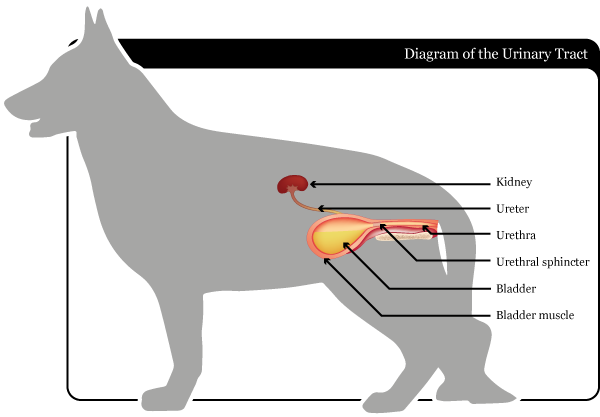Urinary Tract Disease in Dogs
The urinary tract includes the kidneys and the bladder, and the tubes connecting them to each other (the ureters) and to the outside world (the urethra).


One of the most common urinary tract diseases in dogs is cystitis which means inflammation of the bladder. The signs of this condition are similar to those seen in people and include:
• Needing to urinate more often – often they will keep squatting and passing small amounts of urine.
• Straining to urinate.
• Blood in the urine.
• Discomfort when urinating.
These signs are often caused by bacterial infection in the bladder in dogs. To diagnose this problem your vet will ask you some questions about the symptoms you have noticed, and will examine your dog including feeling their bladder where possible. They may also ask for a urine sample to look for evidence of infection, and to send away to a laboratory for culture and sensitivity testing to identify any bacteria present. If it appears that there is an infection they may prescribe appropriate antibiotics. They may wish to check a further urine sample at the end of the course to make sure the treatment has been successful.
They may also ask questions to try to rule out other conditions which can cause your dog to urinate more such as kidney problems and diabetes mellitus (high sugar levels in the blood). If they are worried about this they may also suggest a blood test.
Although many cases of cystitis are due to a simple infection, there are some other conditions which may cause similar symptoms or may predispose your dog to getting an infection. Your vet may suspect this if your dog suffers repeated infections or episodes of symptoms.
These conditions include:
• Bladder tumours.
• Endocrine (hormonal) conditions – conditions like diabetes mellitus (high sugar levels in the blood) and Cushing’s disease (when too much steroid hormone is produced) can make dogs more susceptible to bladder infections.
• Anatomical abnormalities – for example some dogs can be born with the tubes connecting the kidneys to the bladder in the wrong place.
• Prostatic disease in male dogs.
If your vet is concerned this may be the case they may wish to do further tests including:
• Blood tests to check for any endocrine conditions.
• X-rays or ultrasound scans to look for tumours or bladder stones.
If your vet diagnoses any of the above conditions they will then be able to discuss further treatment with you. Some bladder stones can be dissolved using special diets whereas others may need surgical removal. Usually endocrine conditions can be managed using medication and this may then allow any urinary tract infections to resolve with a course of antibiotics.
Disclaimer: This website has been designed to offer information surrounding the use of antibiotics and infection control for pet owners. It does not replace advice from your veterinary surgeon. If you believe your pet is unwell or you have any questions relating to their treatment, please always contact your veterinary surgeon for advice.

